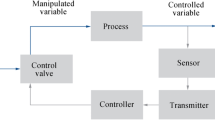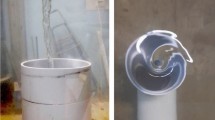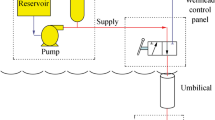Abstract
In the washing machines used for the pressure-cleaning of automotive parts, a pair of 2-way valves frequently reverses the flow direction of the water to spray high-pressurized clean water to remove all oil and dirt from machined engine and transmission blocks. Although this valve system is widely used due to its competitive price, its application can be restricted by the surging effect of a pressure ripple caused by inaccurate valve control during the rapid changes in water flow. As an alternative, a 3-way reversing valve can be used to replace the valve system, to provide rapid and accurate changes in water flow direction without the need of a precise control device. During the use of this alternative valve, however, a cavitation effect often occurs due to a complicated bottom plug shape. In this study, the cavitation index and POC (percent of cavitation) were introduced to numerically evaluate the cavitation effect. To minimize the cavitation effect, an optimal shape design was carried out via parametric study, in which a simple CAE-model was applied in order to avoid time-consuming multi-phase fluid-flow analysis and also to avoid the need for convergence, which is difficult to achieve. A full-factorial DOE and an artificial neural network model provided the optimal values required for a status of nocavitation occurrence: waist length, tail length and POC at 6.50 mm, 6.69 mm and 27%, respectively.
Similar content being viewed by others
Abbreviations
- P 1 :
-
up-stream pressure (Pa)
- P 2 :
-
down-stream pressure (Pa)
- P v :
-
saturated fluid pressure (Pa)
- R B :
-
radius of bubble (mm)
- V 1elem. :
-
volume of unit element (mm3)
- V vapor :
-
volume of vapor (mm3)
- ρ f :
-
density of fluid (kg/m3)
- σ :
-
coefficient of surface tension (N/mm)
- σ v :
-
cavitation index
References
Proceco Ltd, “Cleaning of Automotive Engine Components for Manufacturing,” http://www.proceco.com/industries/automotive/ Aqueous-Parts-Cleaning/Automotive-Aqueous-Cleaning-Engine-Components.php (Accessed 16 FEB 2016)
Nesbitt, B., “Handbook of Valves and Actuators,” Elsevier, pp. 82–93, 2007.
Fran, J. P. and Mechel, J.-M., “Fundamentals of Cavitation,” Fluid Mechanics and Its Applications, Vol. 76, pp. 35–55, 2005.
ISA, “Considerations for Evaluating Control Valve Cavitation,” No. ISA-RP75.23, 1995. http://webdelprofesorulave/ingenieria/oscaror/ CursosDictados/web%20instrumentacion%20industrial/ 3%20desarrollo%20de%20proyectos/normas%20ISA/STANDARD/ RP_7523.PDF (Accessed 2 FEB 2016)
Hubballi, B. and Sondur, V., “A Review on the Prediction of Cavitation Erosion Inception in Hydraulic Control Valves,” International Journal of Emerging Technology and Advanced Engineering, Vol. 3, No. 1, pp. 110–119, 2013.
Jo, S. H., Kim, H. J., and Song, K. W., “A Numerical Study for Reducing Cavitation in a Butterfly Valve with a Perforated Plate,” Proc. of Korean Society for Fluid Machinery, pp. 308–308, 2013.
Kubo, M., Araki, T., and Kimura, S., “Internal Flow Analysis of Nozzles for DI Diesel Engines using a Cavitation Model,” JSAE Review, Vol. 24, No. 3, pp. 255–261, 2003.
Kim, D. K. and Sohn, C. H., “Numerical Study on Cavitation Reduction in Velocity-Control Trim of Valve with High Pressure Drop,” Transactions of the Korean Society of Mechanical Engineers B, Vol. 37, No. 9, pp. 863–871, 2013.
ANSYS, “ANSYS CFX,” http://wwwansyscom/Products/Fluids/ ANSYS-CFX (Accessed 16 FEB 2016)
Fourest, T., Laurens, J.-M., Deletombe, E., Dupas, J., and Arrigoni, M., “Analysis of Bubbles Dynamics Created by Hydrodynamic RAM in Confined Geometries using the Rayleigh-Plesset Equation,” International Journal of Impact Engineering, Vol. 73, pp. 66–74, 2014.
Ko, S., Jang, I., Song, S., “umerical Analysis and Optimal Design to Minimize Cavitation of Vehicle Brake Valve System,” Proc. of KSME, pp. 1248–1250, 2012.
Alfonsi, G., “Reynolds-Averaged Navier-Stokes Equations for Turbulence Modeling,” Applied Mechanics Reviews, Vol. 62, No. 4, Paper No. 040802, 2009.
Menter, F. R., “Review of the Shear-Stress Transport Turbulence Model Experience from an Industrial Perspective,” International Journal of Computational Fluid Dynamics, Vol. 23, No. 4, pp. 305–316, 2009.
Dubey, A. K. and Yadava, V., “Simultaneous Optimization of Multiple Quality Characteristics in Laser Beam Cutting using Taguchi Method,” Int. J. Precis. Eng. Manuf., Vol. 8, No. 4, pp. 10–15, 2007.
Owen, A. B., “Orthogonal Arrays for Computer Experiments, Integration and Visualization,” Statistica Sinica, Vol. 2, No. 2, pp. 439–452, 1992.
SAS Institute Inc., “JMP Statistical Discovery,” http://wwwjmp. com/en_us/software/jmphtml#Design-of-Experiments (Accessed 16 FEB 2016)
Asiltürk, I. and ÇUnkaş, M., “Modeling and Prediction of Surface Roughness in Turning Operations using Artificial Neural Network and Multiple Regression Method,” Expert Systems with Applications, Vol. 38, No. 5, pp. 5826–5832, 2011.
Author information
Authors and Affiliations
Corresponding author
Additional information
This paper was presented at ISGMA 2015
Rights and permissions
About this article
Cite this article
Lee, M.G., Lim, C.S. & Han, S.H. Shape design of the bottom plug used in a 3-way reversing valve to minimize the cavitation effect. Int. J. Precis. Eng. Manuf. 17, 401–406 (2016). https://doi.org/10.1007/s12541-016-0050-8
Received:
Revised:
Accepted:
Published:
Issue Date:
DOI: https://doi.org/10.1007/s12541-016-0050-8




